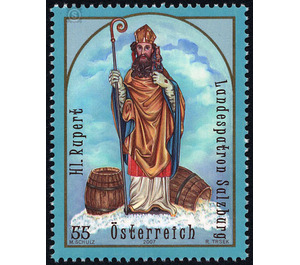patrons - Austria / II. Republic of Austria 2007 - 55 Euro Cent
Theme: Religion & Spirituality
| Country | Austria / II. Republic of Austria |
| Issue Date | 2007 |
| Face Value | 55.00 |
| Edition Issued | 500,000 |
| Printing Type | Photogravure |
| Stamp Type | Commemorative |
| Item Type | Stamp |
| Chronological Issue Number | 2022 |
| Chronological Chapter | OOS-OE2 |
| SID | 799161 |
| In 55 Wishlists | |
On the 24th of September, the people of Salzburg celebrate the feast day of their patron saint. Salzburg celebrates the day of the church on this day and the students from Salzburg have no school. The actual day of remembrance falls on the 27th of March, the day of the death of the saint, but because the celebration is not common in Lent, the "autumn Ruperti" has prevailed. Rupert of Salzburg, born around 650, comes from Worms and presumably came from the family of the Robertins, who were related to the Carolingians. He was Bishop of Worms and was brought to Regensburg by the Bavarian Duke Theodo II at the end of the 7th century. Rupert christened the duke and his entourage. The duke sent the bishop to Salzburg for proselytizing. In 696 St. Peter, the oldest monastery in Austria, was founded on the remains of Roman Juvavum. Also, the nunnery on the Nonnberg is a founding of the saint. His niece Ehrentrudis was the first abbess of the oldest and still uninterrupted existing nunnery in the German-speaking world. The monastery of St. Peter was the starting point of the Christianization of Salzburg Land. Thus, the church foundations of Seekirchen am Wallersee and Bischofshofen are attributed to St. Rupert. He is also said to have erected the Madonna statue in Altötting and thus founded the pilgrimages to the Virgin Mary. From Salzburg the evangelization of Karantanien took place, which covered large parts of the areas of Carinthia and Styria. The economic backing of the monastery formed extensive lands - donations of the Bavarian Duke, but especially the right of salt production in "Hala", the present-day Bad Reichenhall. Rupert died in the year 718 probably in Worms, some sources call also Salzburg. Since 774 his bones are resting in the cathedral of Salzburg. Around the year 850, a Vita of the Saint was written describing that Rupert "died on the day of the resurrection of our Lord Jesus Christ." Saint Rupert is patron saint of salt workers; and Bavaria celebrates him as "Apostle of Bavaria" next to St. Mary as second patron saint. The bishop is usually depicted with a salt barrel, in reference to the Reichenhall salt. Even in Vienna, Saint Rupert is no stranger. The oldest church in Vienna, St. Ruprecht, bears his name. It was the guild church of the salt-boatmen who had built their ships in the area around the church. The name Salzgries reminds of it.


